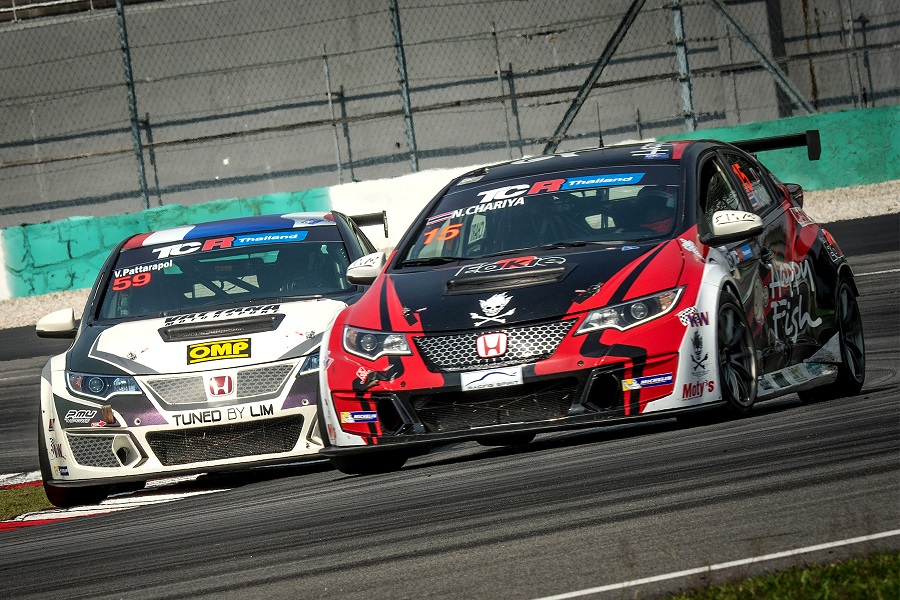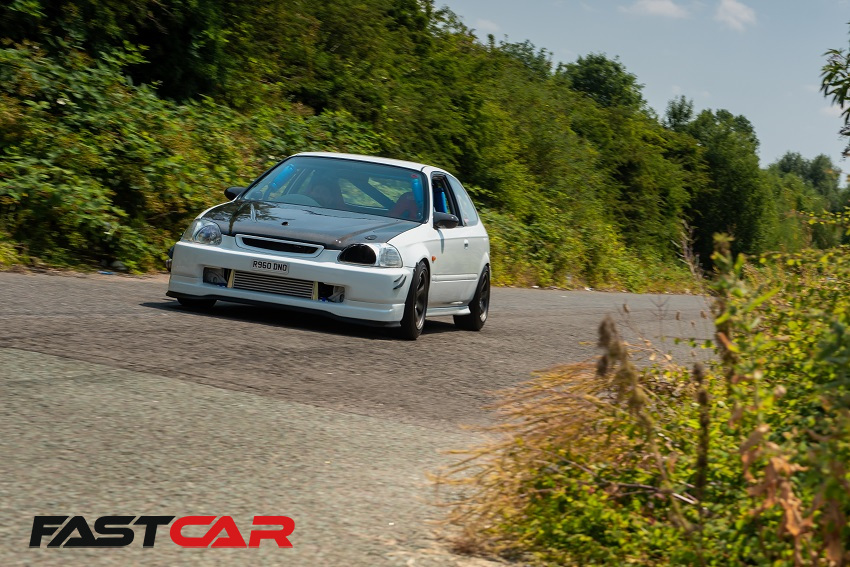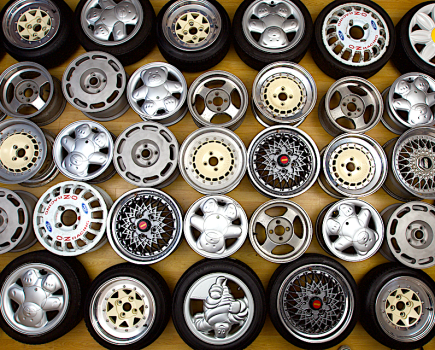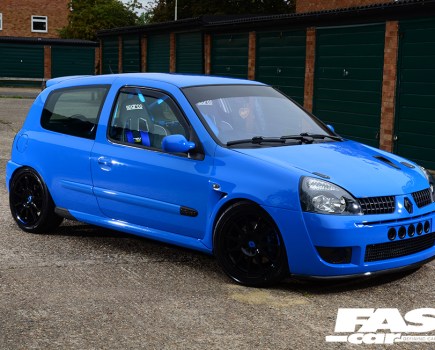Check out this Honda Civic Type R tuning guide to learn how to get the most performance from your FWD pocket rocket!
Honda Civic Type Rs of all ages and generations are fantastic packages to modify. From the factory, they came with playful handling and a range of engines that love to be revved.
Initially reserved for Japan and Europe only, it wasn’t until 2016 when the Honda Civic Type R FK8 released that a genuine USDM model was sold in North America. As a result, it’s the US that has almost been the forefront of Civic Type R tuning of late, but that’s not to say that your household Japanese tuning companies aren’t still producing some of the best tuning upgrades for the Civic. We’ll dive into some of the key modifications you can do to each generation Civic Type R below, but should you want more detailing tuning advice on a particular Civic model, we’ve got you covered with dedicated tuning guides. You’ll spot those under each car’s heading.
Honda Civic Type R EK9 Tuning Guide

If you plan on modifying a genuine EK9 Type R, then you’re a braver person than I. Not because these cars are hard to work on – in fact, they’re a delight – but because they’re becoming increasingly rare and increasingly valuable. Besides, purists would argue that Honda got the recipe spot on at the first attempt. The idea of being so bold as to leave your own mark on its iconic Championship White body panels, or mess with its near-mythical B16B engine is enough to make hardcore JDM fanboys weep.
Happily though, we’re believers of the build process – if you want to personalize your car, no matter how sought after it is, then we’re here to help you do that. Check out our top tips for tuning your EK9 below:
Powertrain Upgrades
- Fit an aftermarket performance induction kit to help channel more air into the car’s engine – just make sure it’s a closed airbox design. Many kits that leave the filter exposed to the high engine temperatures can actually produce *lower* power figures!
- That extra air coming into the engine will only result in additional power if it evacuates just as quickly. A decent free-flowing exhaust system should be your next item on your upgrade list.
- No bolt-on modification is going to produce its true potential without a suitable remap of the car’s ECU and for that we recommend the tried and tested route of the $679/£565 Hondata S300 ECU.
- A new aluminum radiator is a good option, especially if your car’s already producing high water temps and coolant leaks.
- Throw in some lairier cams for an extra splash of power. Pair these with some uprated valve springs and retainers and you’ll also be able to raise the rev limit too.
- You could look at forced induction upgrades, but we’d stay away from boosting the 1.6 and instead look to do an engine swap to a 1.8-litre B18C from an Integra Type R. K20-swaps are possible too, but are more complex and costly.
Handling Upgrades
- A switch to a more aggressive plate-type LSD could enhance the way the car grips out of corners on track. However, if your EK9 is a street car or daily driver, then we’d stick with the stock helical LSD.
- A set of uprated lowering springs is your cheapest option for a lower ride and better handling, though if you can afford some proper coilovers, we’d recommend getting those instead for an added element of adjustability.
- The EK9 comes with cheap and replaceable rubber bushes from the factory, so replacing them with a firmer polyurethane upgrade will make the car feel stiffer on the limit.
- A proper alignment of your EK9’s suspension geometry will allow you to get the best out of the car’s handling.
- Expensive big performance brake kits are largely unnecessary due to the EK9’s lack of mass, but if you have the budget they will offer the ultimate experience in stopping power.
- The OEM wheels are 6.5x15in with a 195-section tire and are fine for most uses, but a set of wider rims with stickier wider tires will enhance grip levels no end. A 205 should fit with no problems and a 215 should be able to be squeezed under the arches with some more aggressive camber or a slightly higher offset wheel.
Aesthetic Upgrades
- The EK9’s interior is pure 90s JDM, with supportive Recaro seats and an alloy gearknob. We’d probably advise to steer clear of going too wild in there. A Nardi or Grip Royal steering wheel would be a nice touch, as would an alloy harness bar and a set of green Takata harnesses.
- There are a host of bolt-on bodywork upgrades that you could make that are also reversible if you ever wanted to return the car to stock. If you do go this route, look to respected JDM brands like Mugen, Spoon and Heko for aero-proven lips, spoilers and wind deflectors.
Looking for an in-depth, EK9-specific tuning guide? Click here.
Honda Civic Type R EP3 Tuning Guide

The EP3 Civic won’t be easy to come across in North America as it was never sold there. However, In Japan, and especially in Europe, the EP3 is one of the most popular and attainable CTR platforms around.
Still fairly reasonably priced (albeit beginning to climb up in valuation), the EP3 is within financial reach of most aspiring car modifiers. One of the most tempting places to start will be under the hood. As standard, these things only have 197hp – plenty to have safe fun with, but not enough if you’re looking for some serious performance.
If you’re going to give your EP3 a few more horses, make sure that you don’t neglect the way it handles either. Otherwise, you’ll find yourself understeering into a hedge. Luckily, we’ve come up with a list of some of the top mods that you should do to your EP3:
Powertrain Upgrades
- Getting your K20 motor breathing right is your first port of call when it comes to engine tuning, and that begins with replacing the stock airbox with an induction kit. You can get small gains with a freer-flowing aftermarket drop-in filter, but ultimately you will need a complete induction kit to release the maximum performance.
- As well as an uprated induction kit, a larger diameter 70mm throttle body and matching uprated inlet manifold will also improve intake speed and volume, but can be quite costly.
- Now that you’ve got more air coming into the engine, you need to get it out again, and for that you need a freer-flowing exhaust system.
- After making some bolt-on changes, you’ll need to have a suitable remap of the ECU to ensure safe running.
- If sticking with the naturally aspirated route, further gains will come from either building the 2.0-litre into a high-compression screamer, or swapping the bottom end for a more torquey 2.4-litre unit from the K24 and retaining the K20 head. Be warned though, this is both complex and costly.
- As ever, when it comes to big power, it’s hard to beat forced induction, and supercharging and turbocharging are both tried and tested options for the K20. Turbocharging gives the best overall power at the expense of throttle response, or alternatively, there’s two different types of supercharger you could opt for. A positive displacement supercharger gives instant boost but is slightly limited on power, whereas a centrifugal supercharger is a happy medium between that and a turbo.
- The EP3 stock six-speed transmission will cope with all but the highest power levels, but the stock clutch certainly won’t, so it’s a good idea to budget for an upgraded clutch.
Handling Upgrades
- The factory 300mm discs, and sliding calipers with their raised ‘Type R’ lettering just don’t quite cut it when the power and therefore the speeds increase. Therefore, the first upgrade for most owners is a simple case of fitting some performance pads and discs
- UK-spec EP3 Type Rs have a conventional open differential from the factory, so one of the best ways to improve the overall driving experience, is to swap that for an LSD.
- A set of uprated lowering springs is your cheapest option for a lower ride and better handling, though if you can afford some proper coilovers, we’d recommend getting those instead for an added element of adjustability.
- The EP3 comes with cheap and replaceable rubber bushes from the factory, so replacing them with a firmer polyurethane upgrade will make the car feel stiffer on the limit.
- A proper alignment of your EP3’s suspension geometry will allow you to get the best out of the car’s handling.
- Stiffer anti-roll bars will help to resist body roll through bends.
- The standard tires are normally 205/45/17s, and an upgrade to a 215 or 225 wide tire, often along with a profile drop to 40, gives a little more grip without needing to do any major arch work.
Aesthetic Upgrades
- The seats are not the best, especially when it comes to lateral loads when cornering hard. Luckily, replacements are aplenty.
- There’s a big movement for people wanting their EP3 Type Rs to look as stock as possible, with only the most minor of styling tweaks, however, if you’re not one of them, feel free to go wild! Everything from subtle lip kits and spoilers to full-on wide arch kits and vented bonnets is available off the shelf, while you can rarely go wrong with swapping out metal parts and panels for lightweight carbon-fiber alternatives.
Looking for an in-depth, EP3-specific tuning guide? Click here.
Honda Civic Type R FN2 Tuning Guide

Everyone loves to dunk on the FN2, or at least they did back in the day. And while it’s still not super common to see these modified, people are at least opening up to the idea that the FN2 can be a pretty solid base for tuning.
When launched, the public scoffed at the fact it had a near-identical powertrain to the outgoing EP3. I mean, so much for innovation, eh? In the present day though, that actually works in its favor. The K20 engine is a tuner’s dream, so there’s plenty that can be done to extract some more power out of your FN2.
Another major gripe that people had about this car when it was new was that it felt a little cumbersome. Admittedly, its suspension isn’t as sophisticated as the EP3’s, and it’s heavier too. But, compared to modern cars, it’s a comparative lightweight. And besides, there’s all sorts of mods that you can do to make the car feel a touch more athletic:
Powertrain Upgrades
- Civic Type R FN2 tuning typically begins with a remap. Don’t expect massive peak power gains though; an extra 15PS or so is all you’ll get from an otherwise stock FN2. The main benefits of the remap are more mid-range torque and a lower VTEC crossover point.
- To make the most of the remap, performance hardware is needed. The main restrictions here, as ever, are inlet and exhaust systems. Naturally aspirated engines are particularly sensitive to exhaust tuning.
- Replacing the stock airbox with an induction kit is your next move, and there are plenty of options to suit your budget.
- A performance inlet and a set of performance camshafts will optimize your N/A engine for around 240PS (after he mods previously mentioned). This is largely accepted as the N/A K20 sweet spot.
- Further tuning will see the use of a larger throttle body, or a set of individual throttle bodies.
- One of the easiest ways to get big power beyond 300PS from Civic Type R FN2 tuning is to add a supercharger kit. The K20 responds well to a bit of added boost; the extra low-down grunt works in harmony with the VTEC’s top end.
- For anything more than mild mods, you need an upgraded clutch.
Handling Upgrades
- The first upgrade for most owners is a simple case of fitting some performance brake pads and discs.
- One of the best ways to improve the overall driving experience, especially on a tuned FN2 Civic Type R, is to swap the open diff for a limited-slip differential.
- The first step is, as always, a set of lowering springs. These are cheap and simultaneously improve both ride and handling and the overall aesthetics too. But for the most noticeable improvement, a set of adjustable coilovers will bring your FN2 Civic Type R to life.
- Working in conjunction with a set of coilovers, uprated anti-roll bars will help tune the FN2 Civic Type R to give even more grip. Many performance upgrades feature multiple settings to make the bar stiffer or softer, so you can play around and find the perfect setup for you.
- One more area of the suspension worth looking at is the bushes. Most of the stock rubber bushes will be worn out by now, so replacing them with a firmer polyurethane upgrade makes a lot of sense.
- Getting the suspension geometry correct is key to fantastic handling.
- The stock wheels and tires are heavy – weighing 22kg each – and there are plenty of aftermarket wheels to choose from. So, ditching the originals in place of some lightweight performance alloys will not only allow you to improve the looks of your FN2 Civic Type R, but you’ll also gain a genuine performance edge too.
Aesthetic Upgrades
-
A Delta Styling rear wing and Mugen-inspired splitters, rear valance, fog vents, and grilles add some extra aggression without being too OTT.
Looking for an in-depth, FN2-specific tuning guide? Click here.
Honda Civic Type R FK2 Tuning Guide

With a production span of just two years (2015-2017), it’s not often that you see a standard FK2 driving about, let alone a modified one. Yet, as its success in TCR racing shows, the core FK2 platform is ripe for some performance-focused fettling.
Truth be told, even in its regular guise, an FK2 would still smoke mildly-modified examples of its predecessors. After all, this was the car that added turbocharging to the CTR DNA. Consequently, the high-pitched ‘revvy’ nature of yesteryear’s N/A engines was sacrificed, but in return, FK2 owners were treated to around 310 horsepower.
To keep everything in check, the FK2 features some very clever suspension, including torque knuckles at the front end. The results are hugely impressive, but that doesn’t mean that you can’t make the FK2 even better…
Powertrain Upgrades
- Given that he the FK2 is already turbocharged, you can see some really worthwhile gains with a simple remap. However, if you want more than 350PS, hold off on the ECU map until after you fit the following bolt-on mods (otherwise you’ll have to shell out for a second map).
- Allowing the K20C’s turbo to suck in some additional fresh air will reap dividends. You can achieve this easily and cheaply by installing an uprated filter into the standard airbox.
- By removing the catalytic converter completely, or ideally replacing it with a freer flowing sports catalyst, you can unleash a fair few ponies, and pave the way for greater gains from the rest of your induction and exhaust mods too.
- More boost means that the standard intercooler can soon run out of flow or will not allow sufficient cooling, stemming the potential power increases in their tracks. To rectify this issue, we recommend an uprated intercooler.
Handling Upgrades
- A good quality coilover will be able to offer a more compliant ride than the +R Button, while also providing performance gains, if it is set-up correctly. Beware, however, that if you want the +R button to work properly and retain its other features (such as sharpened throttle response) but without error messages on the dash, you will need to budget for an electronic damping cancellation kit.
- Anti-roll bars do exactly what they say on the tin – resist your car’s propensity to body roll. By fitting stiffer items you can increase their effect.
- All performance cars benefit from a proper alignment of their suspension geometry and the FK2 Civic Type R is no different.
- The limitation of the stock brake setup is largely down to the pads, which have a relatively small surface area and can overheat under extended periods of hard use and begin to fade. A simple pad swap to some upgraded pads would sort this out straight away.
Aesthetic Upgrades
- There’s not a whole of options for radically changing the FK2’s style, but there is a plethora of carbon parts from bonnets, to boot lids, doors, wings and roof skins to shave weight and add a huge chunk of race car chic.
Looking for an in-depth, FK2-specific tuning guide? Click here.
Honda Civic Type R FK8 Tuning Guide

The current-gen FL5 hasn’t long been available, so for now, we’ll end our tuning round-up with the outgoing FK8.
Whereas the FK2 is a rare sight, its turbocharged FK8 descendent can be spotted worldwide. Being the first truly global Civic Type R, there’s no end of aftermarket companies offering performance parts for it. If you’re based in North America, the FK8 will be the most well-supported Civic Type R that you can get your hands on, while European and Japanese tuners are also spoilt for choice when it comes to local specialists and aftermarket suppliers.
As well as being the most accessible Civic Type R (if not price-wise, then at least in sheer volume terms), it is also the most sporting. That aggressive exterior tells you exactly what this car’s all about, before you even get in it. Designed with almost nothing but performance in mind, the FK8 is arguably the best FWD sports car to exist. Well, at least until the FL5 gets a chance to stake its claim, that is…
In the meantime, here’s some recommended upgrades that you can make to your FK8, if you fancy going supercar hunting.
Powertrain Upgrades
- When it comes to Honda Civic Type R FK8 tuning, the easiest way to get more power out the engine is without a shadow of a doubt a remap, and this alone will be enough to net you an additional 50hp or so.
- The biggest restriction to gas flow is the cat that’s located in the exhaust downpipe. You have two choices here – either go for a de-cat downpipe or a sports cat item.
- An uprated intercooler is always a good idea when you’re upping boost and power as it helps to keep intake air temperatures down, which means the engine won’t pull ignition timing and will be able to make more power more consistently.
- The stock fuel pump is also restrictive and limits how much power you can make – at the basic remap and downpipe stage it will be fine though already running close to its maximum flow rate, and if you want to take things further, you’ll need an upgrade.
- The next stage after this is to make the most of all those supporting mods and fit an uprated turbo.
- At lower power levels, the stock intake, front pipe and exhaust are fine, but once you’re running over 400PS it will be worth upgrading these to minimize restrictions.
Handling Upgrades
- A good value upgrade is a thicker rear anti-roll bar (the stock item is 20.5mm thick), and fitting one will dial out understeer and give the chassis a slight tendency to oversteer, which can be seen as a benefit in a front-wheel drive car.
- Simple lowering springs are a cost-effective way of dropping your ride height. However, if you’re serious about handling and are looking for something that will offer a big upgrade over the stock setup, you’ve got to look at coilovers. These will remove the factory adjustable damping but will give you a lot more adjustment in terms of fine-tuning how the car drives, as well as plenty of lowering range.
- In terms of brakes, the stock setup is absolutely fine for fast road use running stock power, but once you start upping the boost and increasing your speed, you’re definitely going to want to upgrade your stopping power. First up, get a good set of brake pads in the calipers. Then, fit some two-piece discs, which reduce unsprung weight and improve brake cooling.
- As far as wheels are concerned, the FK8 comes with 20s as standard unless you opt for the Sport Line, which came with 19s. Owners have found that dropping down to 18s robs you of steering feel as well as increasing torque steer slightly, however, you can opt for lighter 20-inch wheels, which will reduce unsprung weight.
Aesthetic Upgrades
- The Honda Civic Type R FK8 isn’t short on aggression when it comes to its styling, but there’s plenty you can do to make it look even more special. Splitters, diffusers & carbon bonnets could all be on your shopping list. Check out Mugen’s demo car for some inspiration.
- One last mod that people recommend is a set of rock guards, as the FK8 has a habit of throwing a lot of stones up the sides of the car as you drive along, which will cause paint damage.
Looking for an in-depth, FK8-specific tuning guide? Click here.
Other relevant Honda tuning content:





